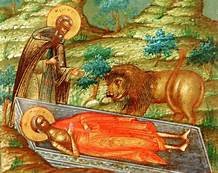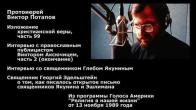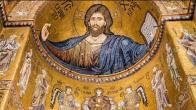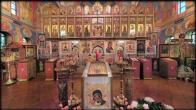You are here
ST.MARY OF EGYPT

From the website of Holy Cross Monastery
We have now reached the end of the most eventful week of the Forty Day Fast, as we celebrate the life of our venerable Mother, Mary of Egypt.
The details of this life are well-known to any faithful Orthodox Christian. They are not very complicated: the chief of sinners becomes the greatest of saints. This story has repeated itself many times throughout the life of the Church. But St. Mary’s life is without doubt one of the clearest and most striking examples, rivalling even the wonderful and unlooked for conversion of the Apostle Paul. As with the great Apostle, so with St. Mary, we see our Lord Jesus Christ show[ing] forth all longsuffering, for a pattern to them which should hereafter believe on him to life everlasting (1 Tim. 1:16).
Let us then consider this pattern of God’s longsuffering and man’s repentance, which the Lord has prepared for us, and in his benevolent providence, has bequeathed to the Church as an immortal treasure. What lessons can we learn from it to benefit our own spiritual life? How can we, weak and miserable though we are, follow to some degree in the footsteps of St. Mary? When we closely observe her life, we can see what was the beginning, middle, and end of her miraculous transformation—faith.
Of course, strictly speaking, the beginning of spiritual life is the grace of God; as Christ says, no man can come to me, except the Father which hath sent me draw him (John 6:44). Spiritual life requires the grace of the Spirit to act on the heart of man, and awaken him to repentance. St. Mary’s life provides a vivid illustration. Indeed, who can fail to be moved by the poignant description of the moment when St. Mary first awoke from the sleep of sin? As she says, “the word of salvation gently touched the eyes of my heart and revealed to me that it was my unclean life which barred the entrance [of the church] to me” (Great Canon, 88). How devastating even a gentle touch from the Lord can be! How it can shatter all of our false self-conceptions! How it can reveal new and hitherto unsuspected depths to our own sinfulness! In such moments, left without any other means of support, our heart, like Mary’s, cries out to the Lord. There, in the full recognition of our frailty and our nothingness, true spiritual life begins—not in some kind of morbid self-abnegation or feigned pious posturing, but in the frank and unflinching acknowledgment that we are abject sinners in desperate need of a savior.
So if we feel that we have been failing miserably this past Lent, that we never overcome our passions or make spiritual progress, but on the contrary, grow worse, more irritable or more indifferent, more susceptible to our passions, then we have not yet failed utterly. The rigors of Lent are not some sort of neatly arranged obstacle course, set up for us so that we can tackle it flawlessly, and then feel good about ourselves, full of smug complacency about our own spiritual state. In some sense, the labors of the Fast are there to bring us to that same point in St. Mary’s life, where we can stand, or rather fall down on our knees, before God, his Mother, and all the saints, relating to them authentically, grounded in a perception of the truth of things, with full awareness of our own poverty. Only there can we make any kind of beginning at all.
But once God has acted, once he has shown us who and what we really are, we are left with a choice. If we accept this new vision, this new revelation of ourselves, which comes by the light of grace, if we receive it with faith and humbly take it to heart, then we have made the first step along the path of repentance, we have begun quite literally to ‘change our minds’, and perceive reality the way God perceives it. The believing heart accepts the rebuke of God’s grace, and then turns with faith to him in prayer, confident in his mercy, seeking deliverance and salvation from him alone.
But woe to us if we have no faith, for it is the key to the doors of repentance, the gate that opens onto the entire realm of the spiritual life. Faith, that is, living faith—not an ineffectual mental assent to some dogmatic formulations, but unswerving trust in the almighty and ever-living God. Without this, as the Apostle says, it is impossible to please [God]: for he that cometh to God must believe that he is, and that he is a rewarder of them that diligently seek him (Heb. 11:6). Indeed, if we did not believe, what cause would there be to strive and bring forth the fruits of repentance, a God-pleasing life? Why would we pray if we did not believe that God hears? Why would we correct ourselves if we did not believe that God sees? Why would we ask for what we need if we did not believe that God can and will provide?
Living faith, on the other hand, finds its natural expression in sincere prayer; it is the wellspring and lifeblood of all true prayer. And so it is also the preservation and perfecting of those God-given moments of heartfelt repentance. We can see this played out in St. Mary’s life. Her spirit’s first response to God’s penitential awakening was to turn in prayer to the Mother of God. Through her intercession, she obtained boldness to enter the church that had previously been barred to her. Having found in the Mother of God a sure protection, and a powerful intercessor before the Lord, Mary gave herself over wholeheartedly to her care and direction. As a child to her mother, she prayed her, “lead me by the hand along the path of repentance!” And in response, she was told, “If you cross the Jordan you will find glorious rest,” (Great Canon, 89).
But before she found that rest, she had to pass through many struggles. The intensity of the trials Mary underwent in the crucible of the desert is unimaginable to us, whose toils and hardships are slight by comparison. Yet she relates to us very plainly the source of her strength to endure them all.
For seventeen years, she waged violent warfare with the passions. Thoughts, feelings, and sensations plagued her constantly, calling her away from her chosen path of repentance and back to a life of debauchery. At times, she could do nothing more than to throw herself on the ground and wait with patient expectation in prayer, calling on the Mother of God, who had become her surety before the throne of Christ’s majesty. In every case, with every temptation, St. Mary tells us that “I always turned the eyes of my mind to my Protectress, asking her to extend help to one who was sinking fast in the waves of the desert. And I always had her as my Helper and the Accepter of my repentance,” (Great Canon 91). Relying on the Mother of God, and the gracious help of her Son, Mary was never put to shame. Through her prayer of faith, she was able to persevere in the movement of repentance that began in the porch of that Jerusalem church. Bereft of every earthly consolation, deprived even of any external spiritual support—a monastic or parish community, the guidance of an elder, the Church and its services, the Holy Scriptures, the writings of the Fathers, regular participation in the Holy Mysteries—Mary obtained all through her faith.
And so it is only fitting that we hear in the epistle appointed for the saint, Ye are all the children of God by faith in Christ Jesus (Gal. 3:26). Faith initiated Mary’s repentance, faith preserved her in repentance, and faith led her to the perfection of repentance, the acquisition of the eternal inheritance of the saints. This is true not only for St. Mary, but for all of us as well; as St. Paul says, ye are all the children of God by faith. The repentance of each one of us can only be founded on the rock of faith; our Christian lives, whether as monastics or laypeople, must be deeply rooted in faith; our own eternal inheritance is secured by nothing other than faith. So let us nurture, let us cherish and preserve our faith as our most precious possession, that we too may be accounted worthy to hear the words spoken by the Savior to the harlot in today’s Gospel: Thy faith hath saved thee, go in peace (Lk. 7:50). Amen.
Relics in cathedral - monthly calendar
| S | M | T | W | T | F | S |
|---|---|---|---|---|---|---|
|
|
|
|
1
|
2
|
3
|
4
|
|
5
|
6
|
7
|
8
|
9
|
10
|
11
|
|
12
|
13
|
14
|
15
|
16
|
17
|
18
|
|
19
|
20
|
21
|
22
|
23
|
24
|
25
|
|
26
|
27
|
28
|
29
|
30
|
31
|
|
PARISH LIFE
Address of our Cathedral
While all the materials on this site are copyrighted, you may use them freely as long as you treat them
with respect and provide attribution on the Russian Orthodox Cathedral of St.John the Baptist of Washington DC.









